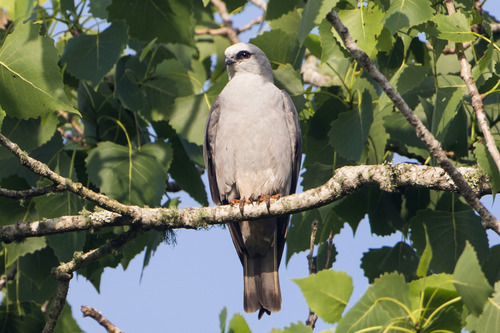
Mississippi Kite
The Mississippi Kite (*Ictinia mississippiensis*) is a graceful, soaring raptor of the southeastern and south-central United States. Known for its elegant flight and almost exclusively insectivorous diet, it plays a crucial ecological role in controlling insect populations, particularly during the breeding season. Unlike many raptors, it is highly social, often nesting in loose colonies and migrating in large flocks. It holds no particular cultural significance beyond its general appreciation as a beautiful and beneficial bird of prey.
30-37 cm
Length
75-90 cm
Wingspan
Least Concern
Conservation Status
Distribution
Primarily found in the southeastern and south-central United States, breeding from the Carolinas west to Texas and north to Kansas and Missouri. Migrates to South America (primarily Argentina, Paraguay, and Bolivia) for the non-breeding season. Rarely found along the east coast of the United States, north of the Carolinas
Lifespan
Up to 8 years recorded in the wild.
Mississippi Kite's Habitat
Habitat Types
Open woodlands, Savannas, Riparian forests, Floodplains, Urban areas with mature trees
Climate Zones
Temperate, Subtropical
Adaptations
Their broad wings and relatively light bodies are adaptations for efficient soaring and aerial hunting of insects. Their migratory behavior allows them to exploit seasonally abundant insect populations in both North and South America.
Variations
No recognized subspecies.
Appearance
Breeding Plumage
Adult plumage is similar year-round.
Seasonal Feather Changes
No significant seasonal variation.
Sex Based Plumage Differences
Males and females have similar plumage: predominantly gray with paler heads and underparts, darker gray wings, and a black tail. Juveniles have streaked underparts and banded tails.
Notable Features
Long, pointed wings, Square-tipped black tail, Red eyes in adults, Relatively small, hooked beak
Diet and Feeding
Primary Foods
Large flying insects, Cicadas, Grasshoppers, Dragonflies, Beetles
Foraging Behavior
Primarily catches insects in flight, often soaring or hovering to spot prey. May also glean insects from foliage or, rarely, take small vertebrates.
Specializations
Agile flight and keen eyesight are specializations for aerial insectivory.
Seasonal Diet Variations
Diet is largely consistent throughout the year, reflecting the availability of flying insects. During migration and in their wintering grounds, they continue to feed on insects.
Behavior
Social Structure
Highly social, especially outside of the breeding season. Often nests in loose colonies and migrates in large flocks.
Communication
High-pitched, whistled calls, "Phee-phew" call is common, Visual displays during courtship
Migration
Long-distance migrant, traveling between North America and South America. Migrates in large flocks, often following coastlines or river valleys. Migration is triggered by changes in day length and insect availability.
Territorial or Group Behaviors
Loosely territorial around the nest site during breeding, but generally tolerant of other kites nearby. Forms communal roosts outside of the breeding season.
Conservation
Threats
Habitat loss (particularly loss of mature trees), Pesticide use (reducing insect prey), Collisions with vehicles and structures
Protection Programs
Protected under the Migratory Bird Treaty Act in the United States, Some habitat conservation efforts benefit this species indirectly
Local National Laws
Protected under various state and federal laws in the United States.
Population Trend
Stable
Population Estimates
Global population estimated at 260,000 individuals.
Interesting Facts
They are known for their graceful, buoyant flight.
Their flight style is often described as 'kite-like,' hence their name.
They sometimes nest in urban areas.
They have adapted to nesting in parks and residential areas with suitable trees.
They will aggressively defend their nests.
They are known to dive-bomb potential predators, including humans, that approach too closely.
Faqs about Mississippi Kite
What do Mississippi Kites eat?
They primarily eat large flying insects, such as cicadas, grasshoppers, and dragonflies.
Where do Mississippi Kites migrate?
They migrate to South America for the winter, primarily to Argentina, Paraguay, and Bolivia.
Are Mississippi Kites endangered?
No, they are classified as Least Concern by the IUCN.
Do Mississippi Kites attack people?
While generally not aggressive towards humans, they *will* actively defend their nests and young. This defense may include close fly-bys and, rarely, making physical contact. It's best to maintain a respectful distance from nests.
Copyright @ Nature Style Limited. All Rights Reserved.
 English
English